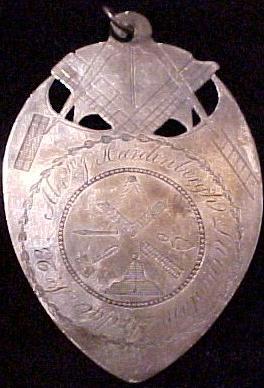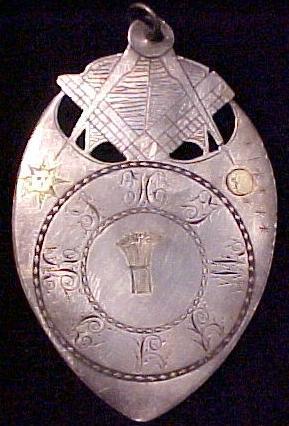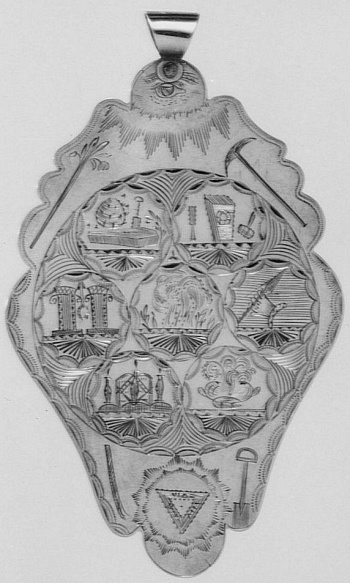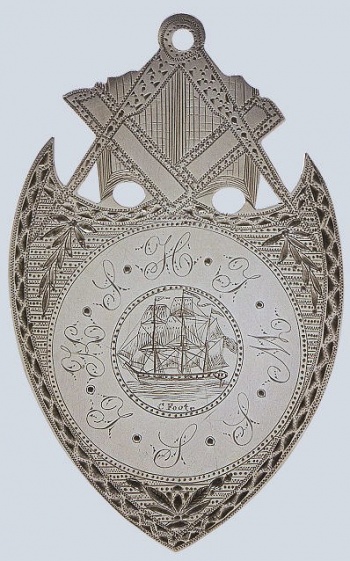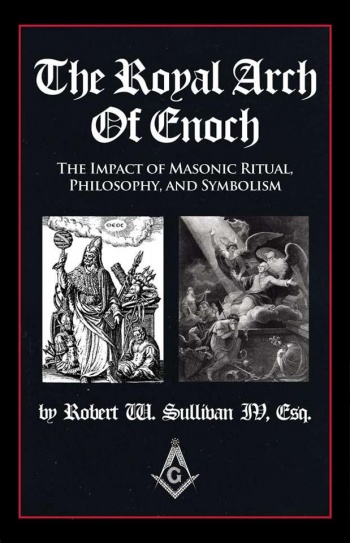En: Revolutionary War Era Royal Arch Mason Jewels: Unterschied zwischen den Versionen
Keine Bearbeitungszusammenfassung |
KKeine Bearbeitungszusammenfassung |
||
| (2 dazwischenliegende Versionen von 2 Benutzern werden nicht angezeigt) | |||
| Zeile 1: | Zeile 1: | ||
== Revolutionary War Era Royal Arch Mason Jewels == | == Revolutionary War Era Royal Arch Mason Jewels == | ||
'''Source: [[Phoenixmasonry]]''' | |||
[[Datei:394881 10151389447817279 1132372262 n.jpg| | [[Datei:394881 10151389447817279 1132372262 n.jpg|350px|right]] | ||
This beautiful hand-made Royal Arch Mason jewel dates to the Revolutionary War and is a fine example of what early Masonic jewels looked like. This jewel has the name of the Lodge and the name of an individual owner. It is engraved Abrm HARDENBERGH, LIVINGSTON LODGE No. 23. It also has the original owners "mark" which is the "sheaf of wheat" on the chapter penny within the circle K, S, H, T, W, S, S, T. These letters are esoteric and cannot be explained here. Royal Arch Masons remember the order of the these letters with the humorous phrase "King Solomon Had Twelve Wives Some Say Twenty". Both sides of this jewel display the Three Great Lights which are the Holy Bible, Square and Compasses. Other working tools on this jewel are the plumb, level, 24 inch gauge, common gavel, chisel and trowel. Other symbolism includes the Sun, Moon and Stars, as well as Jacobs Ladder. It measures 3 inches tall and 2 inches wide and is made of silver. It is a wonderful example of early craftsmanship. | |||
'''Background Sketch of Abraham Hardenbergh''' | '''Background Sketch of Abraham Hardenbergh''' | ||
[[Datei:47067 10151389447767279 802090735 n.jpg| | |||
[[Datei:47067 10151389447767279 802090735 n.jpg|350px|right]] | |||
This background sketch is speculation and needs further research, especially into | This background sketch is speculation and needs further research, especially into | ||
the location and history of Livingston Lodge No. 23, but given the strength of Masonry in old New York, his military and civil career, his social station, and family connections, he is certainly a strong possibility. There are several other men of that name in the family line/NY area, but none of appropriate date. | the location and history of Livingston Lodge No. 23, but given the strength of Masonry in old New York, his military and civil career, his social station, and family connections, he is certainly a strong possibility. There are several other men of that name in the family line/NY area, but none of appropriate date. | ||
| Zeile 20: | Zeile 24: | ||
Dimensions: 1 15/16 x 3 1/16 in. (4.9 x 7.8 cm)]] | Dimensions: 1 15/16 x 3 1/16 in. (4.9 x 7.8 cm)]] | ||
[[Datei:184517 4717416406785 5299771 n.jpg|thumb|350px]] | |||
[[Datei:184517 4717416406785 5299771 n.jpg|thumb|350px|left]] | |||
{{SORTIERUNG:Archmasons}} | |||
[[Kategorie:English]] | |||
Aktuelle Version vom 22. Januar 2019, 16:43 Uhr
Revolutionary War Era Royal Arch Mason Jewels
Source: Phoenixmasonry
This beautiful hand-made Royal Arch Mason jewel dates to the Revolutionary War and is a fine example of what early Masonic jewels looked like. This jewel has the name of the Lodge and the name of an individual owner. It is engraved Abrm HARDENBERGH, LIVINGSTON LODGE No. 23. It also has the original owners "mark" which is the "sheaf of wheat" on the chapter penny within the circle K, S, H, T, W, S, S, T. These letters are esoteric and cannot be explained here. Royal Arch Masons remember the order of the these letters with the humorous phrase "King Solomon Had Twelve Wives Some Say Twenty". Both sides of this jewel display the Three Great Lights which are the Holy Bible, Square and Compasses. Other working tools on this jewel are the plumb, level, 24 inch gauge, common gavel, chisel and trowel. Other symbolism includes the Sun, Moon and Stars, as well as Jacobs Ladder. It measures 3 inches tall and 2 inches wide and is made of silver. It is a wonderful example of early craftsmanship.
Background Sketch of Abraham Hardenbergh
This background sketch is speculation and needs further research, especially into the location and history of Livingston Lodge No. 23, but given the strength of Masonry in old New York, his military and civil career, his social station, and family connections, he is certainly a strong possibility. There are several other men of that name in the family line/NY area, but none of appropriate date.
Abraham Hardenbergh, was born 5 September 1756 in Marbletown NY, son of Leonard and Rachel (Hoogteeling) Hardenbergh. He was a lieutenant during the Revolution and made important contributions as a cartographer. After the war he was appointed a surveyor by the Surveyor General of New York, Simeon DeWitt, for which services he was awarded 1200 acres. With Moses DeWitt, he was responsible for surveying Onondaga County. He was married to Jane Verick, sister of Robert Verick, an important New York City attorney who helped found Jersey City, New Jersey, and who became Speaker of the Assembly in 1788. Abraham died rather young in 1794 (his widow later married his boss, Simeon DeWitt), but enjoyed a full and well-connected career in his short life of only 38 years.]]

